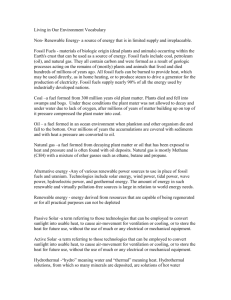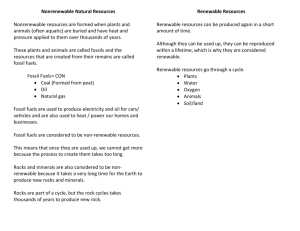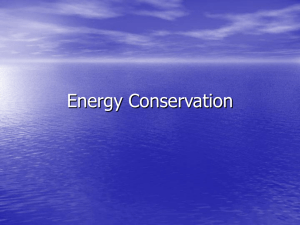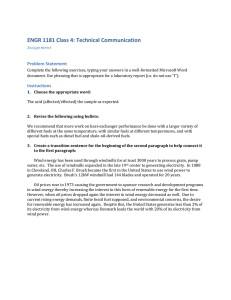Environmental Science Assessment
advertisement
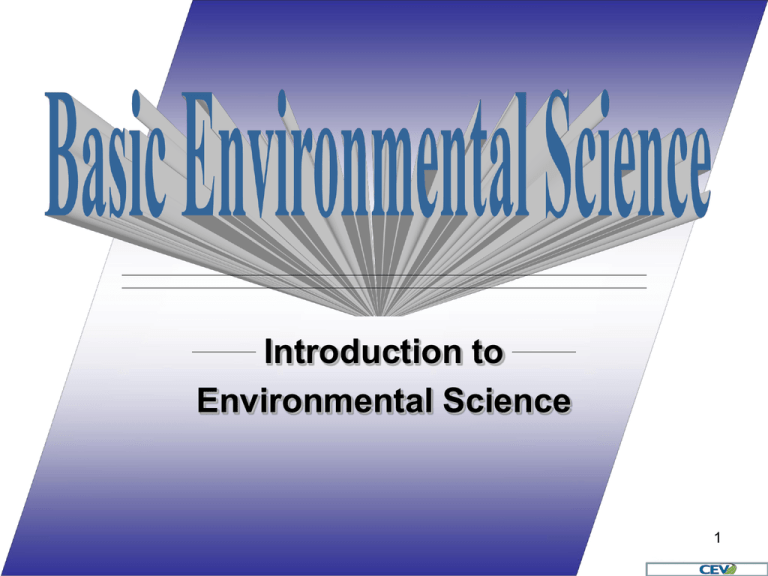
Introduction to Environmental Science 1 Objectives 1. To identify various sources of renewable and nonrenewable energies 2. To understand the basics of alternative fuels 3. To recognize the importance of recycling goods 2 Energy • Energy is the ability to do work or vigorous activity • Two types of energy exist – kinetic – energy in motion – potential – stored energy 3 Energy • There are two categories for energy sources: – renewable – nonrenewable – energy being rapidly used but not easily recreated • Energy can neither be created nor destroyed • Energy can change form 4 Renewable Energy Sources Biomass Energy • Biomass is organic material which has stored sunlight in the form of chemical energy • Biomass fuels are made from natural, renewable sources including wood, agricultural waste and garbage 5 Renewable Energy Sources Geothermal energy • Derived from earth’s core • Eliminates pollution produced with use of fossil fuels 6 Renewable Energy Sources Hydropower • • • • Energy from moving water Most often used Almost free, has no waste products or pollutants Affects natural habitats and changes environments 7 Renewable Energy Sources Solar • Energy converted from the sun into thermal or electrical energy • Drawbacks include large amount of needed space and matter in which the energy reaches the earth’s surface 8 Renewable Energy Sources Wind • Used to generate mechanical power or electricity • Wind turbines convert wind’s kinetic energy into usable forms of energy • Wind turbines cause no pollution, but can be very noisy 9 Nonrenewable Energy Sources Nuclear • Derived from atoms • Process of producing nuclear energy includes splitting of uranium atoms • Disadvantages include production of radioactive waste 10 Nonrenewable Energy Sources Fossil Fuels • Formed over millions and millions of years by action of heat from the Earth’s core and pressure from rock and soil on the remains of dead plants and animals • These sources include oil, natural gas and coal 11 Fossil Fuels Coal • Used to generate more than 50% of all electricity produced in U.S. • When burned, coal emits pollutants into the air 12 Fossil Fuels Oil • Every year the U.S. produces less oil • Every year the demand for oil increases • When burned, oil emits carbon dioxide into the air • Drilling for oil also has negative effects on the environment 13 Fossil Fuels Natural Gas • More than 50% of U.S. homes are heated by natural gas • Advantages: – produces relatively few pollutants – has fewer emissions than coal or oil • Has very little ash emission after burning 14 Conservation of Energy What are alternative fuels? 15 Alternative Fuels • Alternative fuels can be used in place of gasoline and diesel fuels made from petroleum • According to the Department of Energy, the following are classified as alternative fuels: – biodiesel, electricity, ethanol, hydrogen, methanol, natural gas, propane, p-series, solar energy • Using alternative fuels can help reduce U.S. dependence on imported petroleum and improve air quality 16 Alternative Fuels Biodiesel Diesel • Diesel-replacement fuel • Made from natural, renewable sources such as new and used vegetable oils and animal fats • Cleaner source of diesel fuels 17 Alternative Fuels Electricity • Mechanical power can be derived directly from electricity instead of through combustion • Advantages: – no emissions – no pollution 18 Alternative Fuels Ethanol • Alcohol-based alternative fuel • Produced by fermenting and distilling starch crops (barley and wheat) which have been converted into simple sugars • Used in transportation market • Advantages: – reduces dependence on foreign oil – reduces air pollution – renewable fuel 19 Alternative Fuels Hydrogen • H2 • Can be produced in nearly unlimited quantities • Renewable • Emits no toxins or pollutants 20 Alternative Fuels Methanol • Wood-alcohol fuel • Similar to ethanol in chemical structure • As Fuel Cell Technology advances, Electric Vehicles will improve • Will become an important carrier of hydrogen in fuel cells 21 Alternative Fuels Natural Gas • Mixture of hydrocarbons • Produced from gas wells or in conjunction with crude oil production • Clean burning and produces fewer harmful emissions than gasoline 22 Alternative Fuels Propane • Liquefied petroleum gas • Readily available to the general public and produces fewer vehicle emissions than gasoline • Produced as a by-product of crude oil refining and natural gas processing 23 Alternative Fuels P-Series • This fuel is an assortment of natural gas liquids, ethanol and a biomass-derived cosolvent (MTHF) • Made mostly from renewable resources • Most elements are domestically-produced renewable products • Benefits include: – energy security – cleaner environment 24 Alternative Fuels Solar Energy • Electricity derived from the sun • 100% renewable • No emissions 25 Recycling Facts • On average, 4.4 pounds of waste are produced per day per person • Americans will throw away 600 times his or her adult weight in garbage in a lifetime • Each adult will leave a legacy of 90,000 pounds of trash for his/her children • Every Sunday, the United States wastes about 90% of our recyclable newspapers • This wastes about 500,000 trees 26 Answers • Do your research! – surf the net and learn about your community’s recycling program – call and find locations and details of recycling in your town – recycling is easier than you think • Educate yourself! – learn which products can and cannot be recycled – separate your garbage to make recycling easier 27 Commonly Recycled Materials Plastic • Most are recyclable • The industry has developed a code system to identify various types of plastics • Codes may be found at the bottom of plastic containers • Types 1 & 2 are most common found in container form 28 Commonly Recycled Materials Glass • Glass bottles must not be mixed with other types of glass, such as: – window glass – light bulbs – mirrors – Pyrex® – auto glass • Broken glass is very difficult to sort 29 Commonly Recycled Materials Aluminum cans and foil • Empty cans and rinse out to eliminate odors • Separate from other containers • Some recycling centers accept aluminum foil 30 Commonly Recycled Materials Paper • Recyclable paper includes: – newspaper, phone books, mixed paper, office paper and junk mail can be recycled if sorted properly • Non-recyclable papers include: – waxed paper, waxed cardboard milk and juice containers, oil soaked paper, carbon paper, sanitary products or tissues, stickers and plastic laminated paper such as pet food bags and fast food wrappers 31 Commonly Recycled Materials Motor Oil • Used motor oil is considered hazardous waste because it contains heavy metals and other toxic substances • Dangerous to humans and environment if not disposed of properly 32 Things You Can Do. . . • Use products with highly recycled content • Use a canvas bag or backpack at the store rather than plastic or paper bags • Three R’s: – reduce the amount of packaging you buy – reuse what packaging you can – recycle what you cannot reuse 33 Environmental Science Assessment 1. _____ is the ability to do work or vigorous activity. A. Biomass C. Kinetic B. Energy D. Potential 2. Which is the main drawback of using solar energy? A. Harmful emissions C. Radioactive waste B. Limited sources D. Area needed 34 Environmental Science Assessment 3. More than 50% of all electricity produced in the U.S. is generated by coal. (T/F) 4. Which is not an alternative fuel? A. Oil C. Hydrogen B. Biodiesel D. P-Series 35 Environmental Science Assessment 5. Broken glass can be easily sorted at recycling centers. (T/F) 6. Which fuel is produced by fermenting and distilling starch crops? A. Methanol C. Propane B. Ethanol D. Hydrogen 36 Environmental Science Assessment 7. Which of the following recyclable materials is considered hazardous? A. Paper C. Motor Oil B. Plastic D. Aluminum 8. Which of the following is NOT one of the three R’s? A. Recycle C. Reuse B. Rerun D. Reduce 37 Acknowledgements Energy Quest www.energyquest.ca.gov Alternative Fuels Data Center www.adfc.doe.gov Louisiana Dept. of Natural Resources www.leeric.lsu.edu The Internet Consumer Recycling Guide www.obviously.com/recycle/ REACH – Recycling Education Activating Change www.reachrecycling.org Energy Information Administration Kid’s Page www.eia.doe.gov/kids/ Veronica Sparks – Production Coordinator Jennifer Donaldson – Graphics Coordinator Geoff Scott – Production Manager G.W. Davis – Executive Producer MMIII, MMIV CEV Multimedia, Ltd. 38

